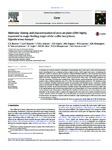Use este identificador para citar ou linkar para este item:
http://www.alice.cnptia.embrapa.br/alice/handle/doc/1003023| Título: | Molecular cloning and characterization of an a-amylase cDNA highly expressed in major feeding stages of the coffee berry borer, Hypothenemus hampei. |
| Autoria: | BEZERRA, C. A.  MACEDO, L. L. P.   AMORIM, T. M. L.   SANTOS, V. O.   FRAGOSO, R. da R.   LUCENA, W. A.   MENEGUIM, A. M.   VALENCIA-JIMENEZ, A.   ENGLER, G.   SILVA, M. C. M. da   SA, M. F. G. de   FREIRE, E. V. S. A.   |
| Afiliação: | FURGS; FURGS; RODRIGO DA ROCHA FRAGOSO, CPAC; WAGNER ALEXANDRE LUCENA, CNPA; IAPAR; UNIVERSITY OF CALDAS, COLOMBIA; INSTITUT NATIONAL DE LA RECHERCHE AGRONOMIQUE, FRANCE; MARIA CRISTINA MATTAR DA SILVA, CENARGEN; MARIA FATIMA GROSSI DE SA, CENARGEN; ERIKA VALERIA SALIBA ALBUQUERQUE FR, CENARGEN. |
| Ano de publicação: | 2014 |
| Referência: | Gene, v. 553, n. 1, p. 7-16, Dec. 2014. |
| Conteúdo: | Abstract: a-Amylases are common enzymes responsible for hydrolyzing starch. Insect-pests, whose larvae develop in seeds, rely obligatorily on a-amylase activity to digest starch, as their major food source. Considering the relevance of insect a-amylases and the natural a-amylase inhibitors present in seeds to protect from insect damage, we report here the molecular cloning and nucleotide sequence of the full-length AmyHha cDNA of the coffee berry borer, Hypothenemus hampei, a major insect-pest of coffee crops. The AmyHha sequence has 1879 bp, containing a 1458 bp open reading frame, which encodes a predicted protein with 485 amino acid residues, with a predicted molecular mass of 51.2 kDa. The deduced protein showed 55?79% identity to other insect a-amylases, including Anthonomus grandis, Ips typographus and Sitophilus oryzae a-amylases. In depth analysis revealed that the highly conserved three amino acid residues (Asp184, Glu220, and Asp285), which compose the catalytic site are also presented in AmyHha amylase. The AmyHha gene seems to be a single copy in the haploid genome and AmyHha transcription levels were found higher in L2 larvae and adult insects, both corresponding to major feeding phases. Modeling of the AmyHha predicted protein uncovered striking structural similarities to the Tenebrio molitor a-amylase also displaying the same amino acid residues involved in enzyme catalysis (Asp184, Glu220 and Asp285). Since AmyHha gene was mostly transcribed in the intestinal tract of H. hampei larvae, the cognate a-amylase could be considered a high valuable target to coffee bean insect control by biotechnological strategies. |
| Thesagro: | Curculionideo Praga de planta Amido Hidrolise |
| NAL Thesaurus: | Curculionidae Gene expression Insect pests Starch Enzymatic hydrolysis |
| Palavras-chave: | Expressão gênica |
| Digital Object Identifier: | 10.1016/j.gene.2014.09.050 |
| Tipo do material: | Artigo de periódico |
| Acesso: | openAccess |
| Aparece nas coleções: | Artigo em periódico indexado (CPAC)  |
Arquivos associados a este item:
| Arquivo | Descrição | Tamanho | Formato | |
|---|---|---|---|---|
| 34279.pdf | 2,25 MB | Adobe PDF |  Visualizar/Abrir |









